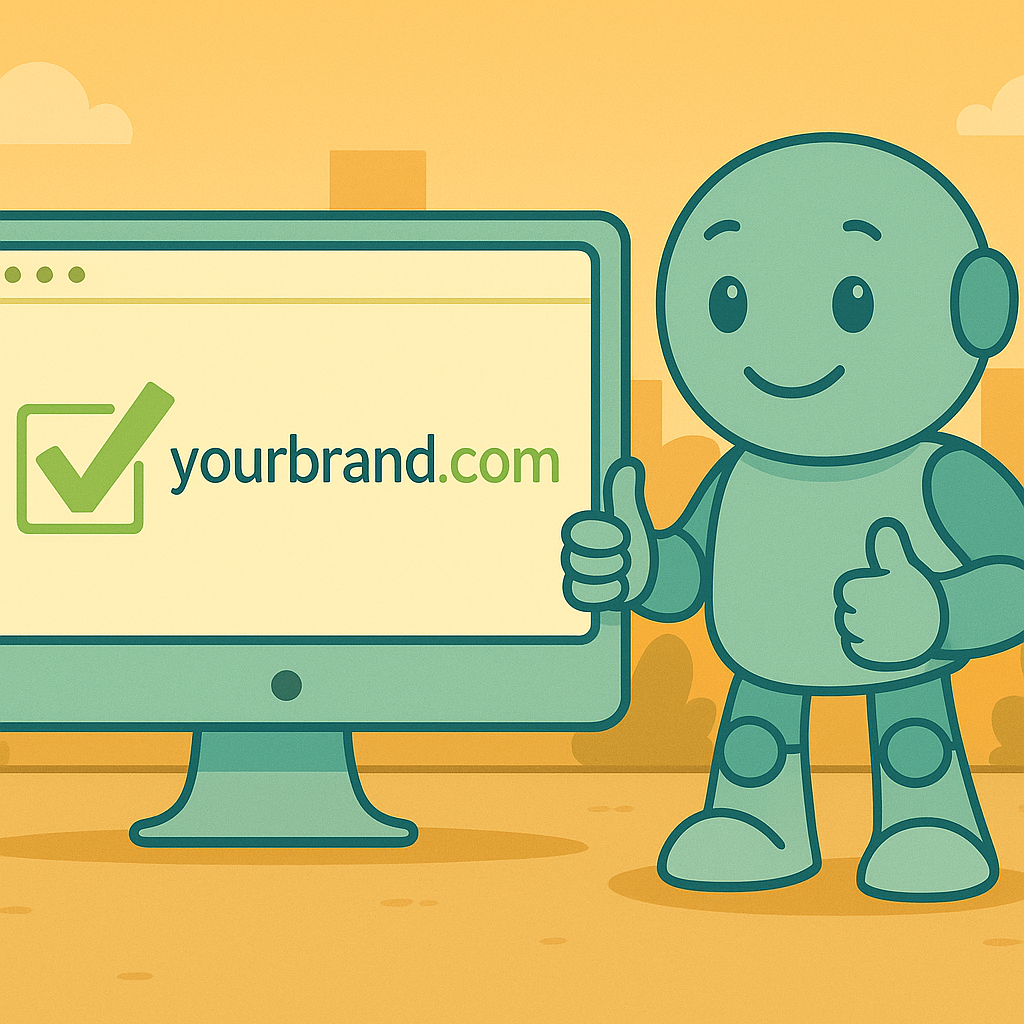How to Pick a Good Business Name That Sticks With Customers
Why Your Business Name Does More Heavy Lifting Than You Think
Your business name isn't just a label; it's the handshake that introduces you to the world. It sets the stage, whispers your story, and shapes perceptions before you even utter a word. Think about brands like Apple, Google, or Nike – they instantly conjure up specific feelings and images. That's the magic of a name that works.
Choosing the right name isn’t a creative afterthought; it's a strategic business decision. I've seen firsthand how a poorly chosen name can hamstring a business. A friend of mine launched a beautiful handcrafted jewelry line, but her business name was so abstract, no one understood what she sold. After months of struggle, she rebranded with a clearer name, and her sales tripled! That taught me a powerful lesson: clarity is just as crucial as creativity.
Finding that sweet spot between creative and clear can be tough. You want a name that's memorable and unique, but also easy to grasp and spell. It needs to resonate with your ideal customer and accurately reflect your brand's personality. And of course, it absolutely has to be legally available. Choosing a good business name is crucial for making a solid first impression. In fact, as of 2025, a whopping 73% of consumers base their initial impression of a brand solely on its name. Discover more insights into business naming trends.

That split-second judgment, that gut feeling a customer gets when they first hear your business name, can have a huge impact on your long-term success. It influences everything from word-of-mouth referrals to how easily people find you on Google. A strong name can generate buzz and excitement, while a confusing or forgettable name can leave potential customers scratching their heads and clicking away. So, how do you find a name that carries that weight? We'll explore that in the following sections, delving into the psychology of memorable names and offering practical tips for brainstorming, testing, and finally choosing a name that sets your business up to thrive.
Finding That Sweet Spot Between Clever and Clear

Picking a great business name is a balancing act. You need that perfect blend of creativity and clarity. A name that's catchy and memorable, yet instantly understandable. Think "Kodak"—catchy, sure, but originally meaningless. Its success gave it meaning. Then there's "General Motors"—perfectly clear, but not exactly exciting. The sweet spot is somewhere in between.
I’ve found brainstorming with both descriptive and abstract words really helps. Imagine you're opening a coffee shop. Your list might include: "brew," "beans," "aroma," "morning," "rise," "cozy," and "urban." Mix and match! You could land on something descriptive like "Urban Bean Coffee" or more evocative, like "Sunrise Brew." It's all about capturing your essence.
Testing Your Clever Name Ideas
Even the cleverest name can bomb if it's hard to use. Do the "phone test": ask someone to spell your potential name after you say it aloud. Stumbling? Red flag. Also, check different fonts. A script font stunner might be illegible in a simpler font. These details matter.
Another thing: abbreviations. I worked with a company whose abbreviated name…well, it wasn't good. They hadn’t thought of it, and things got awkward. Catch this early!
Let's look at some real-world examples to illustrate this balance:
To help illustrate this balance, let's look at some real-world examples:
| Business Type | Creative Name | Clear Name | Pros | Cons |
|---|---|---|---|---|
| Bookstore | "The Book Nook" | "Main Street Books" | Memorable, evokes a cozy feeling | Slightly less clear about what it is |
| Clothing Boutique | "Velvet Rose" | "Everyday Style" | Stylish, hints at a specific aesthetic | Could be seen as niche or limiting |
| Tech Startup | "CodeWeavers" | "Software Solutions Inc." | Intriguing, suggests innovation | Meaning might not be immediately obvious |
| Bakery | "Whisked Away" | "The Bread Basket" | Whimsical, memorable | Could be perceived as more of a cafe |
This table highlights how creative names can be more memorable and evocative, while clear names offer immediate understanding. The ideal name often incorporates elements of both.
Avoiding Naming Pitfalls
Clever can quickly become confusing. That brilliant name in your head might leave everyone else scratching theirs. Avoid names that are too niche, too complex, or rely on inside jokes. Your customers aren't in on the joke yet! Draw them in, don't push them away. Knowing your audience is key.
Finally, think long-term. Will your name still work as your business grows? A name tied to one product or service might box you in later. A broader name gives you flexibility to expand without a costly rebrand.
Testing Whether Your Name Actually Works in Real Life

So you’ve got a list of possible names. Awesome! But before you get too attached, let’s kick the tires a bit. I learned this the hard way. I once fell head-over-heels for a name, only to realize it sounded suspiciously like a contagious disease when spoken out loud. Real-world testing is essential.
The Classic Phone Test and Beyond
The old-school "phone test" is still gold. Call a friend, say the name once, and ask them to spell it back to you. If they trip up, that's a red flag. This catches tricky pronunciations and spellings you might have missed.
Also, play around with different fonts. That gorgeous script might look killer on your logo, but is it readable on a business card? Or in an email signature? Practicality matters.
Don't forget about abbreviations! A friend launched her business with a name that, when shortened, became…well, let's just say it wasn't ideal. Think about all the ways your name could be abbreviated, especially in the land of hashtags.
Does Your Name Travel Well?
Dreaming of world domination? (Or at least expanding beyond your local market?) Then your name needs to translate well, both geographically and culturally. A perfectly innocent word in one language could be offensive in another. A quick Google search can save you from major embarrassment later on.
Brand consistency is also huge. A consistent brand across platforms can boost revenue by up to 23%. That’s no small potatoes. Your name should fit seamlessly with the overall brand identity you're building. Discover more insights on branding consistency.
Real-World Scenarios and Examples
Picture your name in action. On marketing materials. On your website. On product packaging. Even on a billboard or the side of a van! Does it still work? Think of a name like "Flowery Flours." Cute for a local bakery, but what if you want to branch out into other treats? "Sweet Surrender Bakery" gives you more room to grow.
Testing your name isn't about finding the "perfect" name – it doesn't exist. It’s about spotting potential problems before you invest your heart, soul, and bank account into building a brand. Trust me, it's way easier to tweak things now than to rebrand later.
Navigating Legal Hurdles Without Breaking the Bank
So, you've brainstormed that killer business name and put it through its paces. Fantastic! But before you print those business cards, there’s one crucial step left: making sure it's legally yours. This goes way beyond just grabbing a domain name; it's about safeguarding your entire brand identity. Skipping this stage can lead to some serious legal headaches (and expenses) down the line. I actually know someone who launched a really successful clothing line, only to get slapped with a cease-and-desist letter. Turns out another company, in a totally different industry, had already trademarked a similar name. They had to completely rebrand, which cost them months of marketing effort and thousands of dollars. Learn from their mistakes!
Trademark Research: Your First Line of Defense
Before you get too attached to a name, do your homework with a trademark search. Seriously, this is the most important first step. You can often do a basic search online yourself without a lawyer, saving you some cash upfront. The United States Patent and Trademark Office (USPTO) website has a free search tool. Just type in your potential business name and see if anything similar pops up.
This screenshot shows how easy it is to use the USPTO's search interface. Just inputting your potential business name here can give you a good idea of whether or not there are any confusingly similar trademarks already registered. It’s a quick check that can save you a ton of time and money later on.
Don’t forget to check local trademark databases, too, especially if you’re focusing on specific geographic areas. Picking a truly unique name is tough these days. To give you an idea, there were 88.2 million active registered trademarks globally in 2023, and 15.2 million new applications filed that same year! Talk about a crowded field. Here's some more food for thought on trademark stats. Also, this might be an interesting read: Fantasy Business Names: Pros and Cons.
Domain Names vs. Trademarks: Not the Same Thing!
Yes, getting yourname.com is a great feeling, but it doesn’t give you the same protection as a registered trademark. A domain name just reserves your little corner of the internet. A trademark, however, legally protects your brand name and logo, stopping others from using something too close for comfort. Think of it this way: a domain name is like renting an apartment, but a trademark is like owning the whole building.
Protecting Your Chosen Name: The Legal Steps
Once you’ve confirmed your name is available, it’s time to make it official and register your trademark. This means filing an application with the appropriate trademark office. While you can handle this yourself, talking to an intellectual property (IP) attorney can be incredibly helpful, particularly if your business is complex or you're planning to operate across multiple regions. They can help you decipher all the legal mumbo-jumbo and make sure your application is rock solid.
When Naming Conflicts Arise: What to Do
What if you find out someone else is already using a similar name? First, take a deep breath. Don’t panic. Figure out how similar the situation really is. Are they in the same industry as you? Are they actively using the name? If so, you might want to brainstorm some alternative names. If things are murky, talking to an IP attorney can help you figure out your next move. That might involve sending a cease-and-desist letter or even negotiating a coexistence agreement.
Road-Testing Your Final Candidates With Real People
You’ve whittled down your potential business names. Awesome! But hold on before you start printing those business cards. Let’s take those names for a spin in the real world. Just like test-driving a car, you need to make sure your chosen name handles well in different situations. I once saw a friend choose a name that looked fantastic on her website but was a tongue twister to pronounce. She spent half her calls spelling it out – not ideal for creating a great first impression.
Getting Honest Feedback, Not Just Polite Nods
Testing with real people means getting real feedback. Your mom’s not your target audience (unless you’re starting a “Best Mom Ever” mug business). Here's how to get useful feedback:
-
Informal Focus Groups: Grab a few people who represent your target audience and show them your name options. Ask open-ended questions like: “What pops into your head when you hear this name?” “Is it easy to remember?” “Does it feel right for a business like mine?”
-
Social Media Polls: Tap into your network. Create quick polls on Instagram, Twitter, or Facebook, letting people vote on their favorite names or share their thoughts. This gives you fast, broad feedback.
-
Real-World Scenarios: Imagine your name in action. Mock up a business card, a website landing page, or even a draft marketing email. Seeing it “in the wild” can uncover hidden problems.
Here's a quick visual example of how you might compare feedback:
This infographic compares two options, looking at memorability and how easy they are to pronounce. Option A gets an 8/10 for memorability – people are more likely to remember it. But Option B scores a 7/10 for pronounceability, making it potentially easier for customers to share. This kind of comparison shows the importance of balancing different factors. Gathering some quantifiable data like this really helps you make smarter choices. For more ideas, check out this resource on looking beyond the obvious when choosing a name.
Can People Remember and Pronounce Your Name?
An unmemorable or hard-to-pronounce name is a marketing headache. Focus on these key things during your testing:
-
The Phone Test: Have someone read your name to a friend. Then, ask the friend to spell it back. This quickly reveals any tricky spellings or pronunciations.
-
Word-of-Mouth Potential: How does the name sound in a casual conversation? Does it roll off the tongue, or does it feel awkward and clunky? Names that are easy to say have a much better chance of being spread through word-of-mouth.
-
International Considerations: If you plan to go global, check how your name translates and is perceived in different languages and cultures. What seems harmless in English can have surprising (and sometimes embarrassing) meanings elsewhere.
Before you commit to a name, put it through its paces. Think of this as a sneak peek into your brand’s future. You'll uncover potential issues, get invaluable insights, and pick a name that sets your business up for success.
Now you have a solid process to test those final name candidates and make the best decision for your brand. Good luck!
Business Name Testing Methods
Here’s a table summarizing some different ways you can test your potential business name:
| Testing Method | Cost | Time Required | Effectiveness | Best For |
|---|---|---|---|---|
| Informal Focus Groups | Low | Short | Medium | Quick feedback, qualitative insights |
| Social Media Polls | Low | Short | Medium | Broad reach, quantitative data |
| Real-World Scenarios | Low | Short | High | Practical application, uncovering hidden issues |
This table gives you a quick overview of the costs, time investment, and effectiveness of each testing method, helping you choose the best approach for your needs. Remember, using a combination of these methods will give you the most well-rounded perspective.
Making Your Final Call With Confidence
So, you've brainstormed, researched, and tested potential business names. You’re likely down to a few strong contenders. Now comes the tough part: choosing the one. Analysis paralysis is a real threat here. You’ve put in the work – now how do you actually decide?
Weighing the Factors: A Decision-Making Framework
Experienced entrepreneurs have a framework for this exact moment. They don’t just rely on gut feeling (though that’s part of it). They systematically evaluate the final candidates based on specific criteria. This helps take some of the emotion out of it and lets you see the bigger picture. Here’s what I consider:
- Memorability: Does the name stick? Can you easily remember it after hearing it once? Can others?
- Pronunciation and Spelling: Is it easy to say and spell? Avoid names that trip people up.
- Brand Fit: Does it match your brand’s personality, values, and target audience? A whimsical name might not suit a law firm.
- Legal Availability: Can you trademark it? Is the domain name free? This is crucial.
- Scalability: Will the name still work if your business expands and changes direction?
- Personal Connection: Do you actually like it? You’re going to be using this name a lot.
Create a simple table and score each name on these factors. This visual comparison helps you assess your options more objectively.
Breaking Through Analysis Paralysis
Overthinking can be a killer. Trust me, I’ve been there. You second-guess everything. One trick I use? Set a deadline. Give yourself 24 hours to make the final decision. That urgency can help you overcome indecision.
Another tactic I find helpful: visualize your business five years from now. See your chosen name on your website, your marketing materials, maybe even on a building. Does it still resonate? Thinking long-term can reveal potential issues.
Building Confidence in Your Decision
Doubt is totally normal. Even after deciding, you might have those “what if” moments. Here’s how I handle that:
- Trust the Process: You’ve done the research, tested the name, and weighed the pros and cons. Believe in the work you've put in.
- Get Feedback (Again): Share your final choice with a few trusted advisors or some of your target audience. Their input can solidify your confidence.
- Embrace the Imperfect: There’s no such thing as a “perfect” name. Every name has its ups and downs. Focus on the positives and keep moving.
What if You Need to Change Your Name Later?
It happens. Sometimes, even with the best planning, a name just doesn't work out. Maybe there's a legal conflict, or it doesn’t land with your target market. Rebranding is always possible. It might seem daunting, but it’s not the end of the world. Focus on clearly communicating the change to your customers, explaining your reasons. Honesty and transparency are key to maintaining their trust. Check out our guide on how to choose a brand name that drives recognition and sales for more on this.
Choosing a business name is a big deal, but it’s also exciting! With careful thought, thorough testing, and a solid decision-making process, you can pick a name that sets your business up for success. Now, take a deep breath, and make that call! You got this.
Your Next Steps for Naming Success
So, you’ve got the lowdown on picking a killer business name. Now, let’s talk about putting it all into practice. This isn’t about rigid steps, but finding a groove that works for you. It’s more like a choose-your-own-adventure for your brand.
Organizing Your Naming Journey
First, corral all those amazing name ideas you’ve brainstormed. Personally, I love a simple spreadsheet. List each name, then add columns for your criteria: is it memorable? Easy to say? Does it reflect your brand? Is it legally available? This gives you a clear view and makes comparing names much easier.
Next, set realistic deadlines. Don’t rush! Give yourself time to brainstorm, research, and test. Maybe a week for brainstorming, a few days for trademark checks, and another week for feedback from real people. This avoids feeling overwhelmed and lets ideas percolate.
Watch Out for Red Flags, Celebrate Milestones
As you go, watch out for potential problems. Is the name too niche? Too hard to spell? Does it create a weird acronym? These are signs you might need to rethink. On the flip side, celebrate the small victories! Found a legally available name? Snagged the domain name? These wins keep you going.
Resources and Templates to Keep You Going
Don’t start from scratch. Use templates and checklists to stay organized. There are tons of free resources online for trademark searches, domain registration, and even creating questions for focus groups. Use them!
Building Consensus When Everyone Has an Opinion
Working with partners or stakeholders? Getting everyone to agree on a name can be tricky. Set clear evaluation criteria before brainstorming starts. This keeps everyone on the same page and avoids endless debates later.
Here's a simple template to get you started:
| Name Idea | Memorability | Pronounceability | Brand Fit | Legal Availability | Scalability | Overall Score |
|---|---|---|---|---|---|---|
| Name 1 | ||||||
| Name 2 | ||||||
| Name 3 |
This helps you compare names based on what’s important. Remember, the goal isn't "perfect," but the best fit for your business.
Ready to take your naming process to the next level? NameRobot has a bunch of powerful tools and resources to help you choose with confidence. Discover the perfect name for your business with NameRobot!















